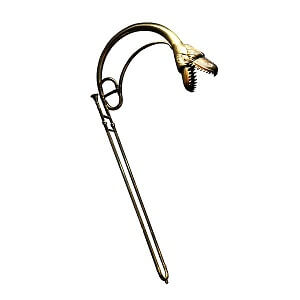Buccin
 Buccin in B-flat (high pitch). Brass. Dual bore type. No tuning slide. The instrument is constructed like an ordinary slide trombone, but the bell branch is conoidal for a greater length and bent in a semi-circle. Instead of a regular bell there is a head of a dragon with wide- open jaws: the jaws, the forked tongue, and the mouth cavity were orginally painted bright red; the head was a bright olive-green, much gilded. Silverplated cup mouthpiece. German silver stockings on the inner slides.
Buccin in B-flat (high pitch). Brass. Dual bore type. No tuning slide. The instrument is constructed like an ordinary slide trombone, but the bell branch is conoidal for a greater length and bent in a semi-circle. Instead of a regular bell there is a head of a dragon with wide- open jaws: the jaws, the forked tongue, and the mouth cavity were orginally painted bright red; the head was a bright olive-green, much gilded. Silverplated cup mouthpiece. German silver stockings on the inner slides.
In the early nineteenth century, some French and Belgian instrument makers manufacturered a fanciful adaptation of the trombone known as the buccin. In place of the standard bell section, it had a widely curving tube ending with a gaudily painted serpent’s or dragon’s head. The same makers also put monster’s heads on serpents, serpent bassoons, and other precursors of the ophicleide.
Putting a dragon’s head on either instrument could only emphasize the worst aspects of their sound. Henri Castil-Blaze, writing in 1821, observed, “This form, picturesque for the eye, essentially harms the results of the instrument, of which it hinders and curtails the vibrations. The sound of the buccin is duller, harsher, and drier than that of the trombone.”